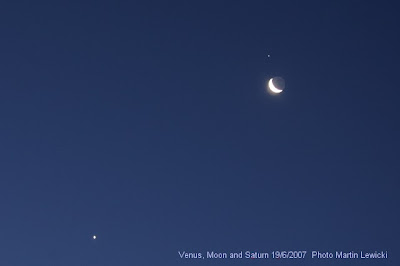You might have noticed her low in the west after dusk shining like a beacon as the Evening Star. Venus is heading between the Earth and Sun for her superior conjunction (see further down) on the 18th this month, after which she becomes the Morning Star.
This sequence shows the appearance of Venus on July 10, 20 and August 6. As it moves between the Earth and Sun waning to a slender crescent increasing size as it gets nearer. On the evening of the last frame I could just make out the crescent in 10x50 binoculars. (Click on image to enlarge). ETX90-EC & Vivitar compact digital.
_____________________________________________________

Later in the Evening, at low elevation just above the horizon before setting, the light of Venus is spread out into a rainbow of rippling colours. Its light is dispersed by thicker layers of our atmosphere that acts rather like a turbulent prism. Maximum digital zoom. ETX90-EC & Vivitar compact digital.
________________________________________


Birth of Venus (Aphrodite) is depicted here emerging from the ocean "foam" in this 1879 rendition by William Bougereau (click to enlarge).
________________________________________

The changing phases of Venus are due to its perspective as seen from Earth as it orbits the Sun. It completes a cycle of phases in about 584 days (19 months). Venus reaches inferior conjunction on August 18 (closest to Earth) when it crosses to the morning sky and the sequence of phases will reverse. On rare occasions Venus will pass in front of the Sun as a Venus transit. http://members.ozemail.com.au/~mlewicki/venustranasit04.html
At superior conjunction it is on the far side of the Sun, appearing very much smaller with the full disk illuminated.
______________________________________
 This is my setup. The Vivitar 3930 camera mounted on a bracket to the Meade ETX90-EC telescope (9cm/3.5"). Planetary photography like you see here is made easier with digital cameras and electronics. You just keep adjusting the exposure settings until you get good shots. The telescope has remote control to reduce shaking from handling and the camera has delay exposure to allow vibrations to subside before exposure. This kind of planetary photography with a small telescope and compact camera would have been almost impossible with film and manual telescope controls.
This is my setup. The Vivitar 3930 camera mounted on a bracket to the Meade ETX90-EC telescope (9cm/3.5"). Planetary photography like you see here is made easier with digital cameras and electronics. You just keep adjusting the exposure settings until you get good shots. The telescope has remote control to reduce shaking from handling and the camera has delay exposure to allow vibrations to subside before exposure. This kind of planetary photography with a small telescope and compact camera would have been almost impossible with film and manual telescope controls.

















